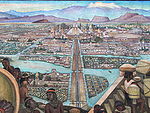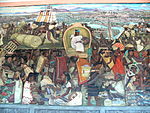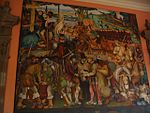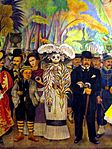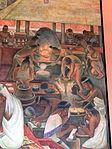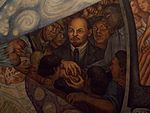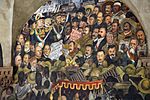- Diego Rivera
-
Diego Rivera 
Frida Kahlo and Diego Rivera in 1932, Photo by: Carl Van VechtenBirth name Diego María de la Concepción Juan Nepomuceno Estanislao de la Rivera y Barrientos Acosta y Rodríguez Born December 8, 1886
Guanajuato, Guanajuato, MexicoDied November 24, 1957 (aged 70)
Mexico City, MexicoNationality Mexican Field Painting, Muralist Training San Carlos Academy Movement Mexican Mural Movement Influenced Glenn Gant Diego María de la Concepción Juan Nepomuceno Estanislao de la Rivera y Barrientos Acosta y Rodríguez (December 8, 1886 – November 24, 1957) was a prominent Mexican painter born in Guanajuato, Guanajuato, an active communist, and husband of Frida Kahlo (1929–1939 and 1940–1954). His large wall works in fresco helped establish the Mexican Mural Renaissance. Between 1922 and 1953, Rivera painted murals among others in Mexico City, Chapingo, Cuernavaca, San Francisco, Detroit, and New York City.[1] In 1931, a retrospective exhibition of his works was held at the Museum of Modern Art in New York City.
Contents
Early life
 Amedeo Modigliani, Portrait of Diego Rivera, 1914
Amedeo Modigliani, Portrait of Diego Rivera, 1914
Diego Rivera was born in Guanajuato, Guanajuato, to a well-to-do family. Rivera was descended from Spanish nobility on his father's side. Diego had a twin brother named Carlos, who died two years after they were born.[2] From the age of ten, Rivera studied art at the Academy of San Carlos in Mexico City. He was sponsored to continue study in Europe by Teodoro A. Dehesa Méndez, the governor of the State of Veracruz.
After arrival in Europe in 1907, Rivera initially went to study with Eduardo Chicharro in Madrid, Spain, and from there went to Paris, France, to live and work with the great gathering of artists in Montparnasse, especially at La Ruche, where his friend Amedeo Modigliani painted his portrait in 1914.[3] His circle of close friends, which included Ilya Ehrenburg, Chaim Soutine, Amadeo Modigliani and Modigliani's wife Jeanne Hébuterne, Max Jacob, gallery owner Leopold Zborowski, and Moise Kisling, was captured for posterity by Marie Vorobieff-Stebelska (Marevna) in her painting "Homage to Friends from Montparnasse" (1962).[4]
In those years, Paris was witnessing the beginning of cubism in paintings by such eminent painters as Pablo Picasso and Georges Braque. From 1913 to 1917, Rivera enthusiastically embraced this new school of art. Around 1917, inspired by Paul Cézanne's paintings, Rivera shifted toward Post-Impressionism with simple forms and large patches of vivid colors. His paintings began to attract attention, and he was able to display them at several exhibitions.
Career in Mexico
 Diego Rivera's mural depicting Mexico's history at the National Palace in Mexico City.
Diego Rivera's mural depicting Mexico's history at the National Palace in Mexico City.
In 1920, urged by Alberto J. Pani, the Mexican ambassador to France, Rivera left France and traveled through Italy studying its art, including Renaissance frescoes. After José Vasconcelos became Minister of Education, Rivera returned to Mexico in 1921 to become involved in the government sponsored Mexican mural program planned by Vasconcelos.[5] (See also Mexican Muralism.) The program included such Mexican artists as José Clemente Orozco, David Alfaro Siqueiros, and Rufino Tamayo, and the French artist Jean Charlot. In January 1922,[6] he painted – experimentally in encaustic – his first significant mural Creation[7] in the Bolívar Auditorium of the National Preparatory School in Mexico City while guarding himself with a pistol against right-wing students.
In the autumn of 1922, Rivera participated in the founding of the Revolutionary Union of Technical Workers, Painters and Sculptors, and later that year he joined the Mexican Communist Party[8] (including its Central Committee). His murals, subsequently painted in fresco only, dealt with Mexican society and reflected the country's 1910 Revolution. Rivera developed his own native style based on large, simplified figures and bold colors with an Aztec influence clearly present in murals at the Secretariat of Public Education in Mexico City[9] begun in September 1922, intended to consist of one hundred and twenty-four frescoes, and finished in 1928.[6]
His art, in a fashion similar to the steles of the Maya, tells stories. The mural "En el Arsenal" (In the Arsenal)[10] shows on the right-hand side Tina Modotti holding an ammunition belt and facing Julio Antonio Mella, in a light hat, and Vittorio Vidali behind in a black hat. However, the En el Arsenal detail shown does not include the right-hand side described nor any of the three individuals mentioned. Rivera's radical political beliefs, attacks on the church and clergy made him a controversial figure even in communist circles. Leon Trotsky lived with Rivera and Kahlo for several months while exiled in Mexico.[11] Some of Rivera's most famous murals are featured at the National School of Agriculture at Chapingo near Texcoco (1925–27), in the Cortés Palace in Cuernavaca (1929–30), and the National Palace in Mexico City (1929–30, 1935).[12][13]
Later work abroad
 Portrait of Diego Rivera, 19 March 1932. Photo by Carl Van Vechten
Portrait of Diego Rivera, 19 March 1932. Photo by Carl Van Vechten
In the autumn of 1927, Rivera arrived in Moscow, accepting an invitation to take part in the celebration of the 10th anniversary of the October Revolution. Subsequently, he was to paint a mural for the Red Army Club in Moscow, but in 1928 he was ordered out by the authorities because of involvement in anti-Soviet politics, and he returned to Mexico. In 1929, Rivera was expelled from the Mexican Communist Party. His 1928 mural In the Arsenal was interpreted by some as evidence of Rivera's prior knowledge of the murder of Julio Antonio Mella allegedly by Stalinist assassin Vittorio Vidali. After divorcing Guadalupe (Lupe) Marin, Rivera married Frida Kahlo in August 1929. Also in 1929, the first English-language book on Rivera, American journalist Ernestine Evans's The Frescoes of Diego Rivera, was published in New York. In December, Rivera accepted a commission to paint murals in the Palace of Cortez in Cuernavaca from the American Ambassador to Mexico.[14]
In September 1930, Rivera accepted an invitation from architect Timothy L. Pflueger to paint for him in San Francisco, California. After arriving in November accompanied by Kahlo, Rivera painted a mural for the City Club of the San Francisco Stock Exchange for US$2,500[15] and a fresco for the California School of Fine Art, later relocated to what is now the Diego Rivera Gallery at the San Francisco Art Institute.[14] Kahlo and Rivera worked and lived at the studio of Ralph Stackpole, who had suggested Rivera to Pflueger. Rivera met Helen Wills Moody, a famous tennis player, who modeled for his City Club mural.[15] In November 1931, Rivera had a retrospective exhibition at the Museum of Modern Art in New York City. Kahlo was present at the opening of the New York MoMA show.[16] Between 1932 and 1933, he completed a famous series of twenty-seven fresco panels entitled Detroit Industry on the walls of an inner court at the Detroit Institute of Arts. During the McCarthyism of the 1950s, a large sign was placed in the courtyard defending the artistic merit of the murals while attacking his politics as "detestable."
His mural Man at the Crossroads, begun in 1933 for the Rockefeller Center in New York City, was removed after a furor erupted in the press over a portrait of Vladimir Lenin it contained. The American poet Archibald MacLeish wrote six "irony-laden" poems about the mural.[17] The New Yorker magazine published E. B. White's poem "I paint what I see: A ballad of artistic integrity".[18] As a result of the negative publicity, a further commission was canceled to paint a mural for an exhibition at the Chicago World's Fair. Rivera issued a statement that with the money left over from the commission of the mural at Rockefeller Center (he was paid in full though the mural was supposedly destroyed. Rumors have floated that the mural was actually covered over rather than brought down and destroyed.), he would repaint the same mural over and over wherever he was asked until the money ran out.
In December 1933, Rivera returned to Mexico, and he repainted Man at the Crossroads in 1934 in the Palacio de Bellas Artes in Mexico City. This surviving version was called Man, Controller of the Universe. On June 5, 1940, invited again by Pflueger, Rivera returned for the last time to the United States to paint a ten-panel mural for the Golden Gate International Exposition in San Francisco. Pan American Unity was completed November 29, 1940. As he was painting, Rivera was on display in front of Exposition attendees. He received US$1,000 per month and US$1,000 for travel expenses.[15] The mural includes representations of two of Pflueger's architectural works as well as portraits of Kahlo, woodcarver Dudley C. Carter, and actress Paulette Goddard, who is depicted holding Rivera's hand as they plant a white tree together.[15] Rivera's assistants on the mural included the pioneer African-American artist, dancer, and textile designer Thelma Johnson Streat. The mural and its archives reside at City College of San Francisco.[19]
Work in museum collections
At Plaza San Jacinto, Mexico City.
- Arizona State University Art Museum, Tempe, Arizona
- Art Institute of Chicago, Illinois
- Arthur Ross Gallery, University of Pennsylvania
- Birmingham Museum & Art Gallery, Great Britain
- Blaisten Collection Museum, Tlatelolco, Mexico City
- Carrillo Gil Art Museum, Mexico City (not on permanent exhibit)
- Centro Cultural MUROS, Cuernavaca, Mexico
- City College of San Francisco, California
- Columbus Museum of Art, Ohio
- DePaul University Museum, Chicago, Illinois
- Detroit Institute of Arts, Michigan
- Diego Rivera House and Study Museum, Mexico City
- Dolores Olmedo Museum, Mexico City
- Fine Arts Museums of San Francisco, California
- Franz Mayer Museum, Mexico City
- Frida Kahlo Museum (Casa Azul), Coyoacan, Mexico City
- Fundación Proa, Buenos Aires, Argentina
- Guilford College Art Gallery, North Carolina
- Harvard University Art Museums, Cambridge, Massachusetts
- Hermitage Museum, Saint Petersburg, Russia
- Honolulu Academy of Arts, Hawaii
- Los Angeles County Museum of Art, California
- McNay Art Museum, San Antonio, Texas
- Metropolitan Museum of Art, New York City
- Milwaukee Art Museum, Wisconsin
- Museo de Arte Moderno, Mexico City
- Museo Diego Rivera Anahuacalli, Coyoacán, Mexico City
- Museo Nacional de Bellas Artes, Buenos Aires, Argentina
- Museo Nacional de Arte (MUNAL), Mexico City
- Museo Soumaya, Mexico City
- Museum of Modern Art, New York City
- National Gallery of Art, Washington, D.C.
- Phoenix Art Museum, Phoenix, Arizona
- Pinacoteca Diego Rivera, Xalapa, Mexico
- Museum of the Rhode Island School of Design, Providence, Rhode Island
- San Diego Museum of Art, California
- São Paulo Museum of Art, Brazil
- Tehran Museum of Contemporary Art, Iran
Personal life
 House of Diego Rivera and Frida Kahlo (built by Juan O'Gorman in 1930)
House of Diego Rivera and Frida Kahlo (built by Juan O'Gorman in 1930)
Rivera began drawing when he was only three, just a year after his twin brother's death. He had been caught drawing on the walls. His parents, rather than punishing him, installed chalkboards and canvas on the walls for the young painter to make use.
As an adult, Rivera was a notorious womanizer who had fathered at least one illegitimate child. He married Angelina Beloff in 1911, and she gave birth to a son, Diego (1916–1918). Maria Vorobieff-Stebelska gave birth to a daughter named Marika in 1918 or 1919 when Rivera was married to Angelina (according to House on the Bridge: Ten Turbulent Years with Diego Rivera and Angelina's memoirs called Memorias). He married his second wife, Guadalupe Marín, in June 1922, with whom he had two daughters: Ruth and Guadalupe. He was still married when he met the art student Frida Kahlo. They married on August 21, 1929 when he was 42 and she was 22. Their mutual infidelities and his violent temper led to divorce in 1939, but they remarried December 8, 1940 in San Francisco. Rivera later married Emma Hurtado, his agent since 1946, on July 29, 1955, one year after Kahlo's death. He died on November 24, 1957.[20]
Rivera was an atheist. His mural Dreams of a Sunday in the Alameda depicted Ignacio Ramírez holding a sign which read, "God does not exist". This work caused a furor, but Rivera refused to remove the inscription. The painting was not shown for 9 years – after Rivera agreed to remove the inscription. He stated: "To affirm 'God does not exist', I do not have to hide behind Don Ignacio Ramírez; I am an atheist and I consider religions to be a form of collective neurosis."[21]
Cinematic portrayals
Diego Rivera was portrayed by Rubén Blades in 1999's Cradle Will Rock, and by Alfred Molina in 2002's Frida.
Gallery
See also
- Mexican Muralism
- Anahuacalli Museum
- Gabriel Bracho, Venezuelan muralist
- Elaine Hamilton
- María Izquierdo
- José Clemente Orozco
- David Alfaro Siqueiros
References
The Tomb of Diego Rivera in The Rotunda of Illustrious Persons inside the Panteón de Dolores
- ^ "Diego Rivera". Olga's Gallery. http://www.abcgallery.com/R/rivera/rivera.html. Retrieved 2007-09-24.
- ^ online biography Retrieved October, 13, 2010
- ^ http://www.flickr.com/photos/32357038@N08/3590825086/
- ^ ([dead link] – Scholar search) M.Marevna, 'Homage to Friends from Montparnasse', 1962, A private collection, Moscow. The State Russian Museum. Archived from the original on October 11, 2007. http://web.archive.org/web/20071011211113/http://rusmuseum.ru/eng/exhibitions/?id=140&year=2003&pic=4. Retrieved 2007-12-14
- ^ "Diego Rivera: Biography". http://www.leninimports.com/diego_rivera.html. Retrieved 2007-09-22.
- ^ a b "Diego Rivera: Chronology". Yahoo! GeoCities. Archived from the original on 2008-03-08. http://web.archive.org/web/20080308142854/http://www.geocities.com/laboronita/dr2.html. Retrieved 2007-09-21.
- ^ Diego Rivera. Creation. / La creación. 1922-3. Olga's Gallery. http://www.abcgallery.com/R/rivera/rivera128.html. Retrieved 2007-12-14
- ^ "Diego Rivera". Fred Buch. http://www.fbuch.com/diego.htm. Retrieved 2007-09-22.
- ^ Diego Rivera. Olga's Gallery. http://www.abcgallery.com/R/rivera/rivera-2.html. Retrieved 2007-12-14
- ^ Diego Rivera. From the cycle: Political Vision of the Mexican People (Court of Fiestas): Insurrection aka The Distribution of Arms. / El Arsenal – Frida Kahlo repartiendoarmas. Olga's Gallery. http://www.abcgallery.com/R/rivera/rivera25.html. Retrieved 2007-12-14
- ^ Chasteen, John Charles. "Born in Blood and Fire". W.W.Norton & Company, 2006, pg. 225
- ^ "Diego Rivera". Encyclopædia Britannica. http://www.britannica.com/hispanic_heritage/article-9063801. Retrieved 2007-09-21.
- ^ "Diego Rivera". Answers.com. http://www.answers.com/topic/diego-rivera. Retrieved 2007-09-21.
- ^ a b "The Commission". San Francisco Art Institute. http://www.sfai.edu/page.aspx?page=35&navID=79§ionID=2. Retrieved 2007-09-22.
- ^ a b c d Poletti, Therese; Tom Paiva (2008). Art Deco San Francisco: The Architecture of Timothy Pflueger. Princeton Architectural Press. ISBN 1568987560. http://books.google.com/?id=tcUhJJJwCoIC.
- ^ Sarah Douglas (May 25, 2005). Rivera Steals the Show at Sotheby's. ARTINFO. http://www.artinfo.com/news/story/815/rivera-steals-the-show-at-sothebys/. Retrieved 2008-04-17
- ^ http://www.enotes.com/poetry-criticism/macleish-archibald
- ^ I paint what I see
- ^ The Diego Rivera Mural Project. City college of San Francisco. http://www.riveramural.org. Retrieved 2007-12-14
- ^ "Diego Rivera — Biography". artinthepicture.com. http://www.artinthepicture.com/artists/Diego_Rivera/biography.html. Retrieved 2007-12-14
- ^ Philip Stein, Siqueiros: His Life and Works (International Publishers Co, 1994), ISBN 0-7178-0706-1, pp176
External links
- Diego Rivera at the Museum of Modern Art
- Diego Rivera at the Open Directory Project
Categories:- Members of El Colegio Nacional
- Cubism
- Mexican artists
- Mexican painters
- Mexican muralists
- Rockefeller Center
- People from Guanajuato, Guanajuato
- People of the New Deal arts projects
- Social realist artists
- 1886 births
- 1957 deaths
- Mexican Trotskyists
- Mexican communists
- Mexican atheists
- Latin American artists of indigenous descent
- Mexican people of Spanish descent
- 19th-century Mexican people
- Frida Kahlo
Wikimedia Foundation. 2010.








